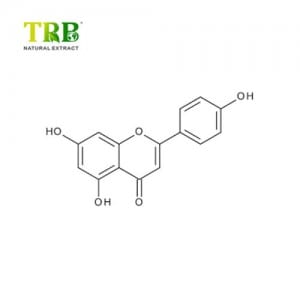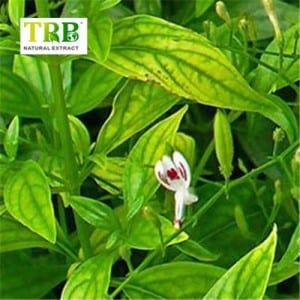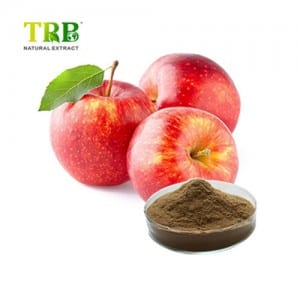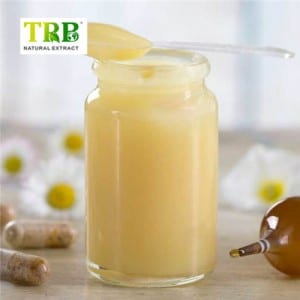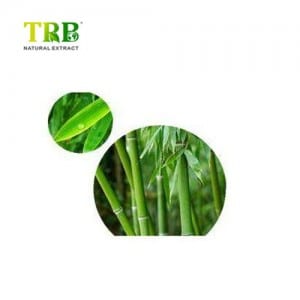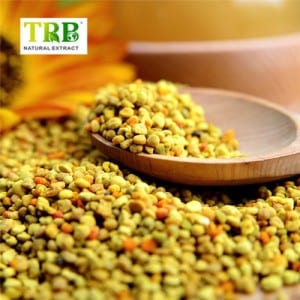Product Name:Vitexin Powder
Other Name:Hawthorn Extract;
Apigenin-8-C-glucoside;8-(β-D-Glucopyranosyl)-4′,5,7-trihydroxyflavone;
Vitexin-2-rhamnoside; Vitexin-2-o-rhamnoside; vitexin 2”-o-beta-l-rhamnoside 8-C-Glucosylapigenin; Orientoside,Apigenin-8-C-glucoside
Botanical Source:Hawthorn,Vigna radiata (Linn.) Wilczek
Assay:2%~98% Vitexin
CAS No:3681-93-4
Colour: Yellow powder with characteristic odor and taste
GMO Status:GMO Free
Packing: in 25kgs fiber drums
Storage:Keep container unopened in cool, dry place,Keep away from strong light
Shelf Life:24 months from date of production
Functions:
- Vitexin has antinociceptive and antispasmodic activities.
- Vitexin exhibits a prominent first-pass effect.
- Vitexin has antioxidant, antimyeloperoxidase, and α-glucosidase inhibitory activities.
- Vitexin can either inhibit or induce activities of CYP2C11 and CYP3A1.
- Vitexin induces the novel p53-dependent metastatic and apoptotic pathway.
6. Vitexin protects brain against cerebral I/R injury, and this effect may be regulated by mitogen-activated protein kinase (MAPK) and apoptosis signaling pathways.
Vitexin Powder: Natural Antioxidant for Cognitive, Cardiovascular & Metabolic Support
Product Overview
Vitexin Powder, a bioactive flavonoid (apigenin-8-C-glucoside) naturally found in plants like hawthorn, passionflower, and mung beans, is a scientifically validated ingredient with potent antioxidant, anti-inflammatory, and neuroprotective properties. Standardized for high purity, this extract is ideal for nutraceuticals, cognitive health supplements, and functional foods targeting modern health concerns such as oxidative stress, metabolic syndrome, and age-related cognitive decline.
(Vitexin Powder, apigenin-8-C-glucoside, antioxidant, neuroprotective, metabolic support)
Key Benefits & Scientific Evidence
Powerful Antioxidant Defense
Neutralizes free radicals and activates Nrf2 pathways, protecting cells from oxidative damage linked to aging and chronic diseases.
Cognitive Enhancement & Neuroprotection
Crosses the blood-brain barrier to inhibit neuroinflammation, support mitochondrial function, and potentially reduce Alzheimer’s risk (backed by PubMed studies).
Cardiovascular Health
Improves endothelial function, regulates blood pressure, and reduces LDL oxidation for heart health.
Metabolic Balance
Enhances insulin sensitivity and glucose metabolism, aiding in diabetes management and weight control.
Anti-Anxiety & Sleep Support
Modulates GABA receptors, promoting relaxation and improved sleep quality without sedation.
(Vitexin benefits, natural neuroprotectant, anti-diabetic flavonoid, GABA modulation)
Applications
Dietary Supplements: Capsules, tablets, or gummies for brain health, heart support, and stress relief.
Functional Foods & Beverages: Added to nootropic drinks, herbal teas, or energy bars.
Cosmeceuticals: Anti-aging serums and creams targeting UV-induced skin damage.
Pharmaceutical Research: Potential adjuvant for neurodegenerative or metabolic disorder therapies.
Private Label Solutions: Custom blends for brands in holistic wellness and clean-label markets.
(nootropic supplements, anti-aging skincare, natural metabolic support)
Quality & Safety Assurance
High Purity: HPLC-verified ≥98% Vitexin content, free from solvents, heavy metals, and microbial contaminants.
Non-GMO & Allergen-Free: Suitable for vegan, gluten-free, and kosher formulations.
Sustainable Sourcing: Ethically harvested from controlled organic farms with full traceability.
Global Compliance: Meets USP, FDA, EU Novel Food, and ISO 9001 standards. COA and MSDS provided.
(non-GMO Vitexin, organic flavonoid extract, ISO certified)
Why Choose Our Vitexin Powder?
Enhanced Bioavailability: Nano-emulsion or cyclodextrin complex options for optimal absorption.
Clinical-Grade Research: Supported by peer-reviewed studies on its multi-target mechanisms.
Flexible Formulations: Available in powder, liquid, or encapsulated forms with MOQs for all scales.
Dedicated Regulatory Support: Guidance on global compliance (EFSA, Health Canada, etc.).
FAQ Section
Is Vitexin safe for daily use?
Yes, it’s Generally Recognized as Safe (GRAS) with no reported adverse effects at recommended dosages (50-200mg/day).
Can Vitexin interact with medications?
Consult a healthcare provider if using blood thinners or antidiabetic drugs, as it may enhance effects.
How does Vitexin compare to other flavonoids like Quercetin?
Vitexin offers unique neuroprotective and metabolic benefits, often used synergistically with Quercetin.
Do you offer sample testing?
Yes! Request free samples and formulation guides via our contact form.
(Vitexin dosage, flavonoid synergy, Vitexin safety)
“Premium Vitexin Powder (98% Purity) – Clinically proven for brain health, heart support, and metabolic balance. Non-GMO, COA-certified, and globally compliant. Ideal for supplements, skincare, and functional foods


